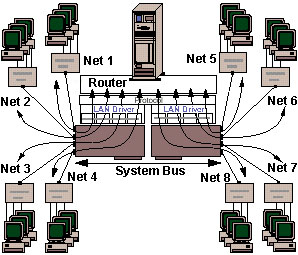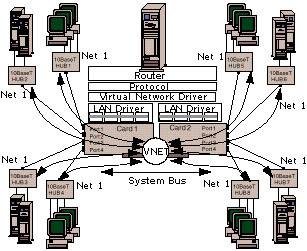|
Peermaster Modes
NOTE I will NOT post the software loading
process. It's TOO damn big. If you want a copy of the Peermaster Installation
PDF, email ME
NOT FINISHED! Don't tell me about the missing example for VNET configs...
Choosing a Mode of Operation
Important! Before you begin installation of your adapter, you
must choose a mode of operation.
Note: Do not attach more than one Quad-B2 PeerMaster 10Base2
port to the same 10Base2 network segment.
You may configure your Quad-BT or -B2 PeerMaster adapter
to operate in either of two modes: the Traditional Adapter mode or VNET
Switch mode. Use the Traditional Adapter mode when you expect little or
no cross-subnetwork traffic. (Subnetwork is also called subnet.)
Use the VNET Switch mode when you need to build subnets to provide cross-segment
traffic. Choose the mode of operation and configuration that fits the needs
of your network. Both modes of operation are described in this section;
examples of configurations begin on page 5.
Traditional Adapter Mode
When the adapter is functioning in this mode, the drivers
for your adapter register each individual LAN segment with the network
operating system (NOS) as a unique subnet. Thus, your NOS views your adapter
as four separate adapters. Therefore, you must configure each network segment
with a unique network number.
All cross-subnet traffic must be routed. Routing
may be performed internally by the server itself, or externally by a local
router. Internal routing is the least expensive alternative, but impairs
server responsiveness by involving the server in frame forwarding. External
routers provide high-performance frame forwarding without impacting the
server. However, they are cumbersome, expensive, and difficult to configure
and manage.
Guidelines for using the Traditional Adapter
mode:
Do not externally join (using bridges, switches, or concentrators)
ports of adapters.
The adapter places no limit on the number of nodes per port.
Ensure that each port is bound to the protocol with a unique network
number.
VNET Switch Mode
When the adapter is operating in this mode, multiple LAN segments
are registered with the NOS as a single subnet, called a VNET. VNETs
are multisegment virtual subnets.
VNETs are made possible by a layer of virtual network
software that binds to multiple instances of the adapter LAN driver and
registers them with the NOS as a single subnet. Multiple PeerMaster adapters
may be configured to interoperate in various ways, such as:
Traditional subnets
One large VNET
Multiple independent VNETs
Any combination of VNETs and traditional subnets
All physical segments within a VNET are configured to the same network
number. Cross-segment traffic within a VNET is switched by your adapter
instead of by your server, allowing the server to be more productive. The
server is shielded from the task of routing, which enables the creation
of powerful switched, multi-segment, high-bandwidth workgroups or departments.
External internetworking devices are not required to provide communication
between segments with a VNET.
Guidelines for using the VNET Switch mode:
Do not externally join (using bridges, switches, or concentrators)
ports of adapters that comprise a VNET.
Configure as many nodes as needed; the adapter places no limit on the
number of nodes per port.
Ensure that all ports in a VNET are bound to the protocol (by way of
VNET) with a common network number.
Examples of Configurations
This section describes the following configurations:
Traditional Adapter mode Samples:
– An 8-port network with two PeerMaster adapters configured in the
Traditional Adapter mode
VNET Switch mode Samples:
– An 8-port network with two PeerMaster adapters configured in the
VNET Switch mode
– An 8-port network with two PeerMaster adapters each configured as
an independent VNET
– An 8-port network with two PeerMaster adapters, one configured in
the VNET Switch mode and the other in the Traditional Adapter mode
Traditional Adapter Mode Configuration

A server with two Quad-BT PeerMaster adapters configured
in the Traditional Adapter mode.
The network protocol views each LAN segment as a separate subnet with
its own network number. Clients on all ports have direct access to the
server.
Note: The same principles
apply to Quad-B2 configurations; however, concentrator hubs are not required
for 10Base2 operation.
o A configuration of eight separate network
numbers.
o Curved arrows illustrating the basic flow
of cross-subnet traffic. The server-based router accepts and forwards all
frames that require routing between subnets.
o Software layers illustrated above the adapters
indicating software that is required to route traffic internally, running
on the server.
o Cross-subnet traffic, such as traffic from
Net 1 to Net 2, must be forwarded by a router. The router can be internal
to the server or an external stand-alone device.
The advantage of the Traditional Adapter mode is that a
router restricts cross-subnet traffic to only those data packets that are
uniquely addressed to the target network. The disadvantage of this mode
is that server responsiveness might be heavily impaired due to the burden
of packet routing. This mode should be used only when little or no cross-subnet
traffic is expected.
VNET Switch Mode Configurations
This section describes three configurations using VNET switch mode.
VNET Switch Mode: Single VNET

Two Quad-BT PeerMaster adapters (Card 1 and Card 2) forming
a single VNET.
In this configuration, the adapter provides the functions of a high-performance
network adapter combined with the power of an Ethernet switching hub.
Note: The same principles
apply to Quad-B2 configurations; however, concentrator hubs are not required
for 10Base2 operation.
o All segments configured as Network number
1 (Net 1).
o Curved arrows indicating the flow of data
across ports connected by the VNET switch.
The VNET switch performs all cross-segment traffic and,
therefore, server responsiveness is not impaired by heavy cross-segment
traffic. The adapters perform two types of frame switching: port-to-port
and peer-to-peer.
|
Type
|
Occurrence
|
Example
|
|
Port-to-port
|
When source and destination ports both reside on same adapter. |
Adapter forwards data packets between ports 1 and 2 of adapter
1 (Card 1).
|
|
Note: Port-to-port switching
is completely transparent to the server microprocessor.
|
|
Peer-to-peer
|
When source and destination ports reside on separate adapters.
Peer-to-peer switching is accomplished through peer data transfers across
MicroChannel bus. |
Adapters forward data packets between port 1 of adapter1 (Card1) and
port 1 of adapter 2 (Card 2). |
VNET Switch Mode: Multiple VNETs
A configuration of two network numbers (Net 1 and Net 2).
An 8-port network with two Quad-BT PeerMaster adapters (Card 1 and
Card 2), each configured as an independent VNET (two VNETs).
Note: The same principles apply to Quad-B2 configurations; however,
concentrator hubs are not required for 10Base2 operation.
The curved arrow that passes through the LAN drivers, protocol stacks,
and router in the server represents the connection between the two subnets
(Net 1 and Net 2). Cross-subnet traffic,
such as traffic from Net 1 to Net 2, must be forwarded by a router.
The router can be internal to the server or an external stand-alone device.
Each VNET may represent a separate department or workgroup.
The four switched ports within each VNET provide a multisegment workgroup
environment. Isolating the two VNETs by way of the server-based router
allows you to create a separation between the two departments. You can
configure the router to permit restricted traffic to pass between the departments.
VNET Configuration 3
Note: Use this configuration only when you expect little or no
cross-VNET traffic.
VNET Switch Mode: Combined VNETs and Traditional Nets
This illustration shows:
A five-subnet network (Net 1, Net 2, Net 3, Net 4, and Net 5) configured
as one four-segment VNET (VNET1) on Card 1 and four traditional networks
on Card 2.
A network using PeerMaster adapters.
Note: The same principles apply to Quad-B2 configurations; however,
hubs are not required for 10Base2 operation.
Cross-subnet traffic, such as traffic from Net 1 to Net 2, must be
forwarded by a router. The router can be internal to the server or an external
stand-alone device.
This VNET may represent a large department while the traditional networks
may represent small workgroups. You can configure the router to restrict
traffic between departments.
9595 Main Page
|

